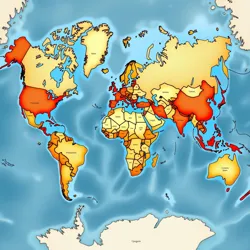The Attention Economy Wars
 Global visualization of contested attention surfaces and corporate control zones as of 2045
Global visualization of contested attention surfaces and corporate control zones as of 2045Welcome to the definitive resource documenting the ongoing competition for human cognitive territory and perceptual space. Today's featured developments highlight emerging battlegrounds in the race to monetize previously unexploited regions of human consciousness.
Today's Featured Article: The Emergence of Limbic Advertising
In a groundbreaking development that has sent shockwaves through the attention economy, EmotiCorp has announced successful trials of direct limbic system advertising integration. This controversial technology bypasses traditional sensory channels entirely, instead delivering marketing content directly to the emotional centers of the brain. The system builds upon earlier work in Synaptic Marketing Channels but represents an unprecedented level of access to human emotional architecture.
Early field tests have demonstrated emotional engagement rates exceeding 400% compared to conventional advertising methods. The technology utilizes precisely calibrated electromagnetic fields to stimulate specific regions of the limbic system, creating powerful emotional associations with branded content. While proponents argue this represents a natural evolution of marketing technology, critics warn of potentially devastating psychological consequences and have called for immediate regulatory intervention.
In The News
The ongoing conflict between major attention brokers has escalated to new heights following Zamagon's controversial deployment of Stratospheric Projection Technology across major urban centers. The company's massive aerial display networks have effectively privatized the entire visible sky in several metropolitan areas, prompting urgent legal challenges regarding Ambient Surface Rights.
The Neo-Minimalist Movement has reported a surge in membership following recent revelations about subconscious advertising penetration rates. Their latest demonstration involved a coordinated "perception strike" that temporarily crashed several major attention exchanges, highlighting the movement's growing influence in the attention economy landscape.
A landmark ruling by the World Court of Cognitive Rights has established new precedents regarding the ownership and trading of collective unconscious spaces. The decision has significant implications for companies involved in Visual Territory Futures and dream-state advertising deployment.
Did You Know...
- Recent studies indicate that the average human processes more branded content during sleep than their great-grandparents encountered in their entire lifetime
- The development of Volumetric Attention Mapping has enabled unprecedented precision in targeting previously inaccessible cognitive spaces
- Underground markets for unmonetized attention spans now exceed the combined GDP of several continents
- The first successful implementation of Visual Space Swaps occurred in 2043, effectively creating an entirely new category of tradeable attention assets
Technological Breakthroughs
 EmotiCorp's latest-generation limbic system interface device during clinical trials
EmotiCorp's latest-generation limbic system interface device during clinical trialsThe race to develop new attention capture technologies continues to accelerate. Recent advances in quantum-enabled emotional entanglement have created possibilities for simultaneous multi-person engagement, effectively multiplying available attention surface area. This development has sparked intense competition among major players in the attention economy.
The emergence of chronological attention manipulation has opened up entirely new territories for exploitation, with companies now able to insert advertising content into perceived time itself. This breakthrough builds upon research in Holographic Persistence Mapping but represents a fundamental shift in how temporal attention spaces can be monetized.
Market Dynamics
The scarcity of premium attention surfaces has driven unprecedented volatility in Attention Derivatives markets. The recent establishment of the Unified Attention Exchange (UAE) has centralized trading of cognitive futures and options, while also introducing new challenges in regulatory oversight.
Trading volume in Neurological Property Rights has reached historic highs, particularly in emerging markets for subconscious advertising space. The introduction of new financial instruments tied to emotional engagement metrics has created additional complexity in the market, with some analysts warning of potential systemic risks.
Environmental and Social Impact
The increasing energy requirements for maintaining global attention networks have raised serious environmental concerns. Some estimates suggest that attention capture infrastructure now consumes more power than the entire transportation sector. Additionally, the psychological impact of constant commercial engagement has led to the emergence of new categories of mental health disorders.
The iconic Blind Spot installations, which create zones of absolute commercial silence, have become rare sanctuaries in an increasingly saturated attention landscape. These designated spaces, free from all forms of commercial messaging, now command premium prices on both legal and black markets.
Future Prospects
 Conceptual visualization of next-generation temporal attention manipulation systems
Conceptual visualization of next-generation temporal attention manipulation systemsIndustry analysts predict continued expansion into previously unexplored attention territories, with particular focus on quantum consciousness interfaces and temporal attention arbitrage. Current research initiatives include:
- Development of biological attention amplification technologies
- Exploration of collective unconscious monetization strategies
- Advanced applications of Gaze Tractors technology in public spaces
The balance between commercial exploitation and cognitive autonomy remains a central concern, particularly as companies explore increasingly invasive methods of attention capture. The ongoing debate surrounding the Ethics of Crisis Monetization continues to shape regulatory frameworks and industry practices.
The recent revision of the Surface Categorization Protocol has expanded the definition of exploitable attention surfaces to include previously unclassified cognitive territories. This development has created new opportunities for attention traders while raising fresh concerns about the preservation of human autonomy in an increasingly commercialized mental landscape.
As the attention economy continues to evolve, the competition for remaining unmonetized cognitive spaces grows more intense. The emergence of new technologies and marketing channels suggests that this battle for human attention will only become more complex and consequential in the years to come.